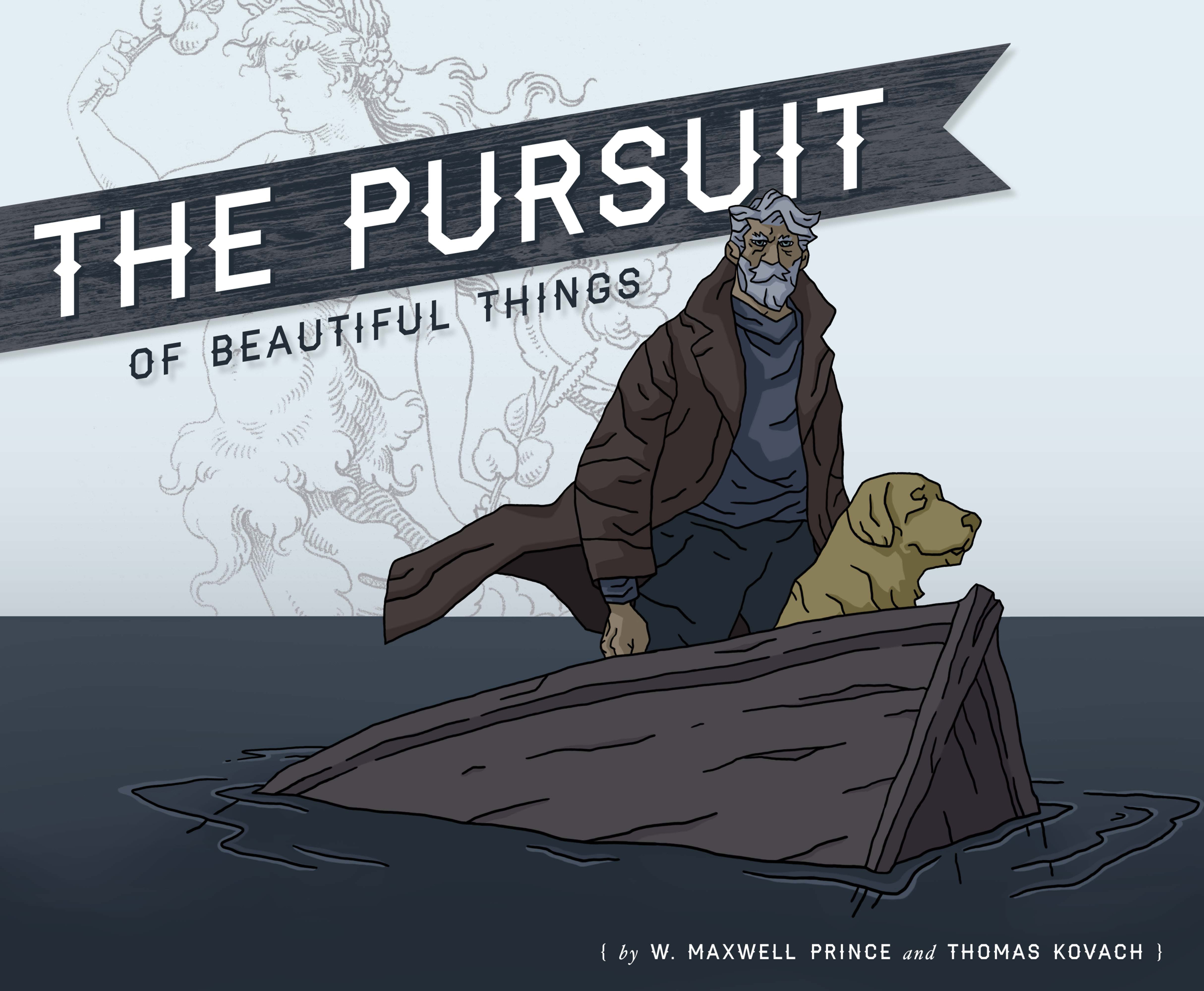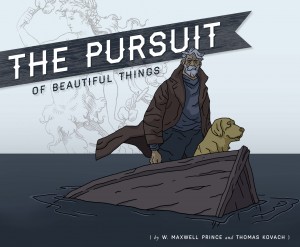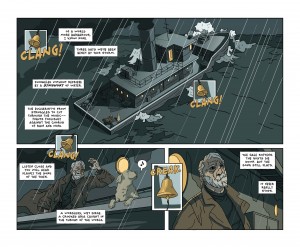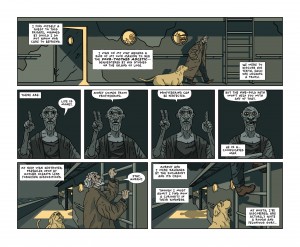ComiXology Submit lauched on March 6, 2013, as a platform for independent comics creators to upload their comics, wait for approval, and if accepted, market their comics directly through ComiXology at a 50% profit share (minus mobile distributor fees and credit card fees before the split). To all accounts, it sounds like an amazing opportunity for the exponentially growing field of self-publication. The descriptions and FAQ answers on their website essentially confirm that it really is that easy a process, with only three steps. How does a comic get “accepted”, though? Based, the website says, on “professional content”, though they admit that’s an area they are working to define. The comic creator retains the rights to their works and can publish elsewhere in this “non-exclusive” agreement. The Submit program really caters to creators looking to avoid the complications of using a middle man as distributor in their flow-pattern for publication. When I found a new creator who was launching a comic through Submit this week, I thought I’d hear from him what his experience was like from start to finish, and W. Maxwell Prince kindly supplied me with a narrative time-line for his new work THE PURSUIT OF BEAUTIFUL THINGS, drawn by Thomas Kovach and lettered by Jason Arthur.
Prince said:
“I’d be happy to elucidate the Submit process, though I think I can speak more to its potential significance for a self-starter than the actual experience of submission, which all told was pretty simple and straight forward. (Upload, await the curatorial judgement of unknown parties at Comixology, and hope you get emails with some good news, etc.)”.
So the process really is just as the website explains, a kind of dream come true in electronic ease. Point one for the Submit program, taking the stress out of the submission process for indie creators. But I was also interested in Prince’s career leading up to this decision and why he chose Submit so close to its launch. Was he striking out with other methods, or just in the right place at the right time?
Prince explained:
To start with the story, this project began as a bit of decompression for me. I’ve been working on a graphic novel called The Judas Chronicles for the last 2.5 years or so. The production of that book has been so circuit-blowing and psychically demanding that I wanted to make sure I was still able to create something that WASN’T that, something of a different tone and scope. I decided to create a short comic at untraditional dimensions. It seemed if I was going to challenge myself past the paralysis of this other heavy book, that a push to the farthest edges of my comfort zone would be worthwhile. What I didn’t know, I suppose, is that this story would transform into a thesis about creation, simultaneously talking to the nature of “beautiful things” while also implicating myself as a writer and the decisions I make in subject matter. The short quickly became very sad and very strange, which, as far as my reading is concerned, are my two favorite shapes for a work of art to take. (And in my experience, stories that manage to be both sad and strange also tend to be rather good.) And Thomas, my artist, just kept turning in one homerun page after another.With its weird size and semi-oblique narrative style, I wasn’t too sure what to do with it.
So, Prince is dealing with a comic here that he was concerned might not fit into traditional formats in terms of size, shape, and content. It isn’t a superhero comic, or an autobio comic, which seem synonymous with mainstream and indie from a distance. He was exploring new territory, even in terms of his own career and output, and the experimental nature of the comic gave him pause as to how to publish or market it. That suggests that something like Submit breaks down stereotypes of what indie comics can and should be, letting the reader decide, instead, what they want. And Prince’s comic, despite its unconventional aspects, was still considered “professional content”, a reassuring thing. But for Prince, this formed a confluence with the fact that he was, indeed, in the right place at the right time, so to speak, finishing this project just as Submit was launched.
Prince clarified:
Lo, but 2 days later, Submit was announced. It seemed a peculiar confluence of events, the completion of this little ditty and the seemingly revolutionary advent of the Submit portal. But I got the feeling it was the perfect way to solve the problem of allowing other people to sample the sadness and strangeness of this thing (at first but a side project) that became very important to me in its form and content.
But how does this all relate to Prince’s expectations of format? Was he someone who had worked in a digital format before, or was this a leap of faith into the digital revolution for him? And more importantly, did he feel that this was a compromise on such an individual vision for a comic, or was it a natural thing for this new project to take digital form? It’s a far cry from traditional indie self-promotion at cons and through freebies, for one thing, though Submit does offer a preview of its comics to readers for free.
Prince revealed his own professional background thus:
I think there’s a lot of prognostication about what “digital” is going to mean for the comic book world. There’s still a fair amount of dithering as to how print and electronic reading are going to co-exist for future readerships. I come from traditional trade publishing (I worked for 2 major publication houses for quite a while), and I can tell you that there, the discussion has shifted from how is this going to change things to something more like how has this already made everything different? I think for a self-starter, Submit is about how things are different, today, right now. One can still go through the drudgery (lovely as it is) of printing on-demand ashcans and twiddling their thumbs away in the creator section of some convention. There is much to recommend the benefits of the old mode of “self-publishing”, and much to admire in the energy and enthusiasm required of one to be successful at that. But as far as I understand things, most of the world’s limited attention, all day every day, is held within the confines and pixels of a bright box. So Submit means a greater chance of nabbing that small chunk of attentive real-estate, of being held up alongside (or perhaps more accurately, somewhere off to the side, but not as far away as before) creators who already have the platform to reach an audience. (One might think of Brian K. Vaughn and his recent digital efforts, released not surprisingly at a different size than traditional trade comics.) Since we’re all not Brian K. Vaughn (I guess there’s only one), some of us need a bit of scaffolding to pull off a digital release. I’m no good at the internet, so to have it all built in for me like this was a treat.
Prince clearly has a knowledge of the old-fashioned ways of promoting and indie comic, and while he doesn’t denigrate that legwork (and often expensive self-production methods), he’s seeing a speedier way of claiming an idea. The faster something’s in print, the sooner it’s coined an idea in reader’s imaginations. It’s a typical conversation in comics for someone to admit they’ve been working on a project for months, but have just seen the same idea published ahead of them in the shop. That’s not a bad side-effect to speedy publication, the capturing of ideas in a timely fashion when indie comics often take so long to produce and go the rounds on distribution, tying things up. It’s one of the appeals of digital publishing for free on one’s own website, but Submit is offering a marketing method, too. I suppose that runs the risk of creators publishing too quickly and then wishing to make revisions, and it’s not clear what updates might be possible to a comic on Submit if that were the case. Something to keep in mind.
But for Prince, it’s not just about creating a comic and being proud of it, finally seeing it out there for public consumption. Like many indie creators, he’s starved for the knowledge that readership can actually reach his story, at long last.
Prince explained:
I imagine it’s the goal of most writers and artists to elicit something from a reader. I know for myself, I create things so as to leave no one unmoved. But that little bit of fragile magic doesn’t work unless people are actually reading your stuff. So at least there’s the chance now, on the most widely-used comics app and website that services this ever-strange medium, for me to seduce a reader in the way I’ve been seduced so many times before, in print and more frequently on an iPad app.
Prince’s last observation here was not only very funny, but very sharp. He’s experienced as a tech user in the mainstream mode, buying apps and digital comics, even, and he knows that when his comic is placed along others on a level playing field, he has a fair shot of attracting readers. Maybe that’s the really appealing thing about Submit. You’re not competing with mega famous names in comics just to get your comic on a link. Sure, you’re still competing when it comes to sales, but the more indie creators are working through these kind of programs, the larger body of indie work readers have to choose from, and find their own tastes based on the merits of the comics. It’s not overly idealistic to assume that readers will actually try new things given a chance to explore, in fact, one of the most common complaints I hear from readers today is that they are tired of feeling as if they’ve already read the comics they’ve just bought once they have a closer look. Variety and new ideas are definitely still appealing to comics readers.
Prince’s new comic is an impressive 16-pager, by the way, with artwork that’s eye-catching and colors to create its own watery atmosphere with a mythical ethos. It’s tag-line reads: “One Man. A ship full of knaves. And the hunt for something beautiful”. It’s the kind of story you might easily see in DARK HORSE PRESENTS, and just as high quality in writing and production. So, if you’re wondering what kinds of people are using Submit, and what kind of comics are finding their way onto this new publication platform, now you know. W. Maxwell Prince is using it, and he’s been very happy with his experience, and judging from THE PURSUIT OF BEAUTIFUL THINGS, readers are going to be happy, too, with the increasing availability of indie works through Submit.
Hannah Means-Shannon writes and blogs about comics for TRIP CITY and Sequart.org and is currently working on books about Neil Gaiman and Alan Moore for Sequart. She is @hannahmenzies on Twitter and hannahmenziesblog on WordPress.












This is a great interview that covers a lot of ground. I think it really comes down to what is best for the project and relevance via a potential audience. Hopefully more voices can be heard this way. I’m going to pick this up on Comixology. All the best! ~ CB
Glad you liked it and found it helpful! Big thanks to Prince for participating and sharing his perspective.
Comments are closed.